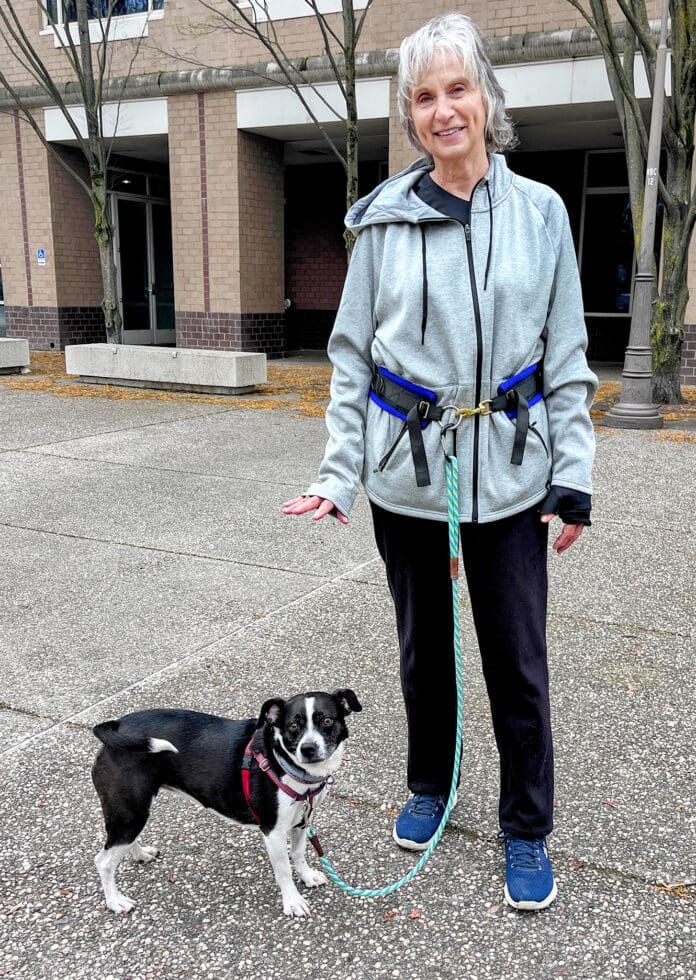
Hands-free dog walking belts are worn around the waist to provide a place to attach a dog’s leash so it doesn’t have to be hand-held – or when the can’t be easily held, as in the case of one of our product testers. Sue recently had surgery on her hand and has to wear a cast for weeks and weeks, making it difficult to walk her 5-year-old, 28-pound, mixed-breed dog, AbbyRoo. Sue and Abby were the perfect pair to help us evaluate these dog-walking waist belts.
Some dog walking belts are as simple as a nylon strap with a single buckle fastener, one piece of adjustment hardware, and a lone D-ring where the wearer can use a carabiner or clip to attach the dog’s leash. Others offer padding, pockets, multiple places to adjust their fit, multiple attachment points for dog leashes, and/or places to attach other accessories, such as treat pouches, folding water bowls, and poop-bag holders.
Because their features and design vary widely, so does the cost of these belts. We’ve seen simple products for as low as $6 (from shein.com) and fancy products for as much as $60 (from neewadogs.com). We didn’t select either one of those for review, as the cheap one seemed ridiculously flimsy, and the most expensive one seemed needlessly weighed-down with features that few of us need. Instead, we evaluated four products that are more comfortable than the minimal, cut-into-your-waist straps, and less burdensome than the products that are perhaps meant to carry lots of gear with you and your dog on day-long hikes.
How are hands-free dog-walking belts used?
Dog walking belts tend to be used in two different ways: to either discourage dogs from pulling or enable dogs to pull.
People with dogs like Abby, who take advantage of any lapse in their leash-holder’s attention to lunge toward stuff they are interested in, might use a waist belt for its ability to provide more consistent and secure resistance to lunges or pulling. Many people automatically or unintentionally allow their arms to be yanked toward their pulling dogs, unwittingly providing a variable, bungee-like, shock-absorbing experience for the dog.
Also, many dogs quickly learn that if they lunge or pull hard enough, they can often catch us off guard or out-muscle us, allowing them to reach the things they want to get close to, which essentially reinforces that behavior.
But a fixed-length leash that is securely attached to a human’s waist won’t respond in quite the same way as one that’s attached to the end of our long, bendable, and perhaps relatively weak arms! When dogs lunge or pull against a leash that’s fastened to a waist belt, they are much less likely to succeed in reaching what they are pulling toward – and without that reinforcement, many dogs stop pulling and lunging.
Then there are people who use waist belts for sports where the dog is encouraged to pull: canicross (cross-country running with dogs) and skijoring (where a person on skis is pulled across snow or ice by a dog or dogs). The human-worn belts and dog harnesses for these sports are designed differently than dog-walking belts. Sport-pulling belts are built to provide more coverage around the human’s hips and rump, and the dog harnesses are designed to help the dogs pull, with the force distributed across their chests without impeding their shoulders. We did not include products for these sports in this review.
Traits we want in a dog-walking belt
The foremost feature that any hands-free dog walking belt must have is strength. If you’re not going to be holding the leash, the belt needs to be up to the job. We looked for products that are well made with strong materials – and were disappointed with the fasteners on two of the belts we tested, particularly because they both came from companies with a reputation for well-made, quality products. Neither product failed during the time that we tested them, but we lack confidence in their ability to secure large (or even medium-sized) dogs who pull like AbbyRoo!
The second most important feature we were looking for is comfort for the wearer. The wider the dog walking belt, the greater the force distribution, and the more comfortable it is. Wide belts distribute the force of any pulling or lunging across a wider area of your body where a narrow strap would cut into you.
Some of the manufacturers of these products seem bent on enabling the attachment of as many accessories as possible. While it can be helpful to carry drinking bowls, treat pouches, poop bag-holders, extra leashes, and slobber towels with us on walks, we really don’t want all of that attached to the same dog walking belt that’s leashing our dog!
It should be noted that none of these products are sized for larger-sized humans. The White Pine Walk-a-Belt is the largest product we found, with a waist that extends to a maximum of 54 inches. Lest that sound gigantic to you smaller-sized humans, remember that these belts go on over one’s clothing, which can entail quite a few layers for dog-walking in the winter.
Whole Dog Journal is reader-supported. If you purchase through links on our site we may earn a commission. Whole Dog Journal does not accept money for its food and product reviews.
Whole Dog Journal’s Top pick:
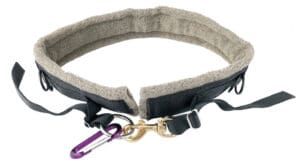
Our favorite dog-walking belt is the Walk-A-Belt from White Pine Outfitters. It’s the widest belt with the most padding, a simple design, and super strong.
The Walk-A-Belt is made with a continuous length of 2-inch-wide web, which is sewn to 3-inch wide, Polarfleece padding. It fastens in the front with hardware that seems exceptionally strong (and which can be completely removed so the belt can be machine washed). With your dog’s leash attached to a big stainless-steel O-ring with a carabineer in the front of the belt, your dog can walk in front of you or on either side equally comfortably. There are D-rings sewn to either side of the belt to clipping on accessories.
Runners up
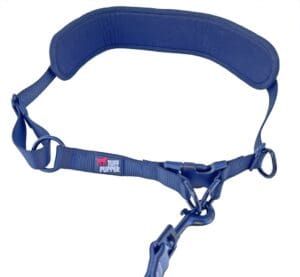
Our next favorite waist belt is the Tuff Pupper Hands Free Bungee Dog Leash. (Note: We originally found this product on Amazon, where it was called the Tuff Pupper Heavy Duty Hands Free Leash.)
Like our top pick, it has a relatively simple design, with a 1-inch-wide, web belt that runs through a 3-inch-wide neoprene padded lumbar section. The belt fastens in front of the wearer with a plastic buckle (similar to a dog collar buckle but the dog’s leash is attached to the belt via two metal D-rings, which are sewn to either end of the belt for maximum security. This attachment makes the plastic buckle, which might be considered the belt’s weakest link, redundant.
There is also an extra D-ring that you can use to clip accessories onto. It’s built into the belt in a clever way; you can slide it into whatever position on the belt you prefer.
As you might guess from its name, the Tuff Pupper Hands Free Bungee Dog Leash comes with a heavy leash that has strong elastic sections. We don’t like “bungee” leashes; they encourage dogs to pull to reach what they want, and you can’t pull the dog back to a predictable length if you need to. We used the dog walking belt with one of our regular leashes.
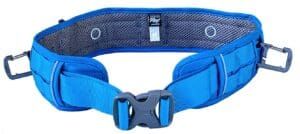
We’d rank the RSG Active Utility Belt from Kurgo as our third choice. It’s as wide as our top pick, but not as comfortable nor as secure, with a large but thin plastic buckle in the front. It offers two connection points for dog leashes, one on either side of the belt, and while the hardware for these attachments is easy to use, it doesn’t feel all that strong.
That said, this product might make the top pick of someone with a smaller dog (or a dog who is not prone to pulling) who brings a bunch of accessories with them on the trail. The belt has a number of MOLLE-compatible attachment sites (MOLLE, pronounced “Molly,” stands for “modular, lightweight load-carrying equipment”).
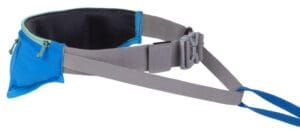
We usually love products from Ruffwear, but we were disappointed with its Trail Runner Running Belt. The webbing that gives these belts their strength is used on only the front half of this belt’s circumference, with the slightly padded fanny pack making up the rear section. Also, the plastic buckles used to fasten the belt and the leash-attachment strap that secures the dog seem wimpy.
Your product rankings may differ
Sue, our cast-wearing product tester, had greater appreciation for some features than we did. She liked the front-attachment site and zippered pockets of Ruffwear’s Trail Runner. However, she was concerned about how the leash-attachment strap would lengthen as Abby pulled on walks; it just wouldn’t stay adjusted.
Also, Sue liked all the attachment options on Kurgo’s RSG Active Utility Belt, which we feel are unnecessary. But as the owner of a smaller (though strong!) dog, she understood our concern about how secure these belts would be if one were walking a larger, stronger dog.
If, like Sue, you have a smaller dog, or you have a dog who doesn’t pull hard and you just want your hands free, the apparent strength of the belts may not be a selection priority for you.
Best Dog Walking Belts
| Price | Sizes | Notes | ||
|---|---|---|---|---|
| 4 PAWS | High Sierra Walk-a-Belt White Pine Outfitter | small (32 to 46 inches) medium (38 to 54 inches) | Quality hardware, most comfortable to wear. D-rings on the sides enable wearer to snap on accessories; they are not for attaching leashes. The metal hardware used for the leash attachment at the belt’s front is easily removed so the belt can be machine-washed. White Pine also sells an “Original” version that has a plastic buckle fastener, for use with toy and smaller dogs ($40). Company promises that if the product doesn’t fit or you’re not happy with it, you can return it within 30 days of purchase and they’ll replace it or give you a refund. | |
| 3 PAWS | Tuff Pupper Hands Free Bungee Dog Leash Tuff Pupper | $25 to 28 | one size of belt (25 to 42 inches) two sizes of leash: small/medium (dogs 20 to 45 lbs) large (dogs 45 to 125 lbs) | The web used for this belt is only 1 inch wide, but is a thicker material than that used for Kurgo’s or Ruffwear’s product; it’s also continuous, extending through the 3-inch-wide neoprene-padded lumbar section in the back. A plastic buckle fastens the front – but the dog’s leash is clipped onto metal D-rings on either end of the belt in front (making the plastic buckle redundant) for maximum strength and security. The product comes with a leash that has a bungee section, which we didn’t use. |
| 2.5 PAWS | RSG Active Utility Belt Kurgo | One size (28 to 45 inches) | Belt is 3 inches wide, with two hooks for attaching a leash on either side of the belt; no front attachments points. Leash-attachment hardware is easy to use but seems insubstantial; we wouldn’t be confident using this belt with a hard-pulling larger dog. Only thinly padded. MOLLE-compatible design allows you to add accessories to the belt. Kurgo says that, if during your product’s lifetime, it does not function as it should due to a manufacturing defect, they will replace the product free of charge. | |
| 2 Paws | Trail Runner Running Belt Ruff Wear | small (20 to 35 inches) large/XL (35 to 50 inches) | The user attaches a leash to by running a strap on the front through the handle of the leash. Enabling the dog to walk in front of or on either side. The nylon web that makes up the front of this product is only 1 1/2 inches wide – and it doesn’t extend through the back of the belt. The web that is used to attach the leash is narrower still: just 3/4 inches wide, fastening with an even smaller, lighter plastic buckle. We would not recommend using this belt with a hard-pulling larger dog. |







I loved using my Buddy Belt when walking my dogs. At one point, we had three small dogs and I had them all hooked up to me. 🙂 I have RA in my hands, so holding that many leashes was a no-go for me. I also added a pouch on my belt for the poop bags, tissues, and a mini stun gun. We live in a very windy area so having any spray deterrent might blow back on me or my dog(s). Thankfully I never had to use it.
My chow/golden mix Roxy weighs 53 pounds and was a confirmed puller. I have a whole collection of patented devices that are supposed to solve the pulling problem. None of them worked. Then a few years ago I came up with the same solution as this article mentions, but I improvised. I took the carrying belt off a canvas briefcase I happened to have. It was a contour belt, nicely padded and meant to carry the brief case slung over the shoulder. But it worked beautifully as a no-pull belt for walking Roxy–when she pulled against my weight, she stopped, unlike pulling against my bungee-cord arm. It took only one long walk before she was no longer pulling. However, I would advise against using a belt around the waist. Before the dog learns to stop pulling, a sudden jerk on the belt could hurt your back. For comfort and safety, I wear my belt a little lower, around my upper hips. Good luck with all those confirmed pullers out there. This works!